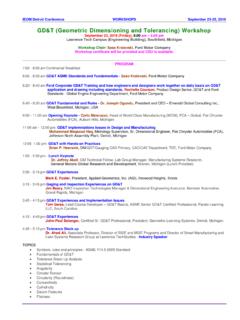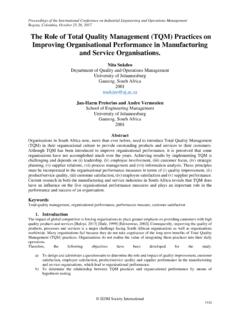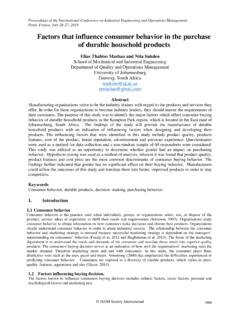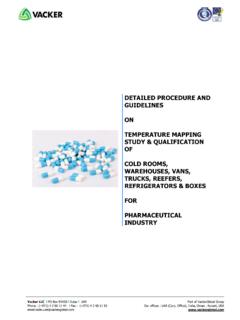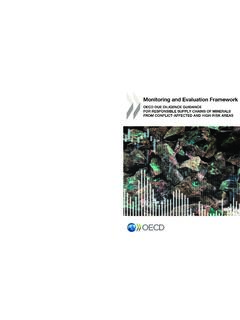Transcription of FMEA AIAG-VDA - Commentary and Case Study - IEOM Society
1 Proceedings of the International Conference on Industrial Engineering and Operations Management dubai , March 6-8, 2020 IEOM Society International FMEA AIAG-VDA - Commentary and Case Study Edly F. Ramly Certification Director EFR Certification Sdn Bhd, Malaysia @efrcertificationHood Atan IATF Auditor Exergy Management Consultant Malaysia Abstract Automotive Industry Action Group ( aiag ) and Verband der Automobilindustrie (VDA) jointly published a FMEA handbook to be used by automotive suppliers to assist them in development of FMEA. Since the handbook newly published in June 2019, there are several issues in adopting the reference manual. This paper explores the common issues and benefits in developing the Process FMEA by using the the AIAG-VDA handbook through two case Study . The output of this paper provide the Commentary of strength, benefit and issues in developing PFMEA through AIAG-VDA FMEA handbook.
2 Keywords: Risk Assessment, Risk Management, FMEA, Operation Management, IATF. reference manual that outline the guideline for Failure Mode Effect Analysis (FMEA) published by Automotive Industry Action Group ( aiag ) 4th edition in year 2008, has been updated with new handbook. The new handbook was published jointly by aiag which is based in United States of America and Verband der Automobilindustrie (VDA) which is based in Germany in June 2019. In 2017- 2018, we conducted case Study in implementation of FMEA and determined that there are seven issues in implementation of FMEA and concluded as followed (Ramly and Atan, 2018): PFMEA is proven risk assessment methodology to prevent defects. However, there are seven issues that face by the organization and the team that develop the PFMEA for their manufacturing process.
3 The issues include determining whether to develop the design FMEA or process FMEA, setting up the objectives of PFMEA, determining the processes, determining the severity score, listing the causes, determining occurrence score, determining control and prioritizing the improvement. Each of the issue have the proposed solution as discussed in previous paper. The future research should focus on linking the PFMEA and other quality improvement tools such as cause and effect diagram, control plan and application of PFMEA in quality improvement initiatives such as six sigma and lean manufacturing. Hence this paper conducted additional case Study with two organization in order to Study and provide Commentary : -The main difference between the aiag 4th Edition FMEA handbook vs AIAG-VDA 1st edition handbook;-The benefit of implementing the PFMEA according to AIAG-VDA FMEA handbook;-The issues and limitation of the AIAG-VDA FMEA handbook;2957 Proceedings of the International Conference on Industrial Engineering and Operations Management dubai , March 6-8, 2020 IEOM Society International - Recommended solution to minimise the issues and limitation in implementing the PFMEA according to AIAG-VDA FMEA handbook.
4 AIAG-VDA FMEA handbook provide guideline for Design FMEA (DFMEA), Process FMEA (PFMEA), and monitoring system response (MSR FMEA). However, since both organizations in the case Study are not design responsible, hence the Study and Commentary are limited to Process FMEA (PFMEA) as prescribed in section III of the AIAG-VDA FMEA handbook. Improvement of aiag /VDA PFMEA framework From the 2017-2018 Study of FMEA develop by Ramly and Atan (2018), the aiag / VDA FMEA framework complement and improve 6 out of seven issues recommended in the from the papers as followed: 1. Product or process Addressed 2. Defect Prevention Partially Addressed 3. Process Flow Not addressed 4. Effects to determine severity score - Addressed 5. Top three causes Partially Addressed 6.
5 Determining occurrence score - Addressed 7. Continual Improvement Prioritization - Addressed Product or Process The previous reference manual ( aiag , 2008) not clearly addressed the context of organization in developing the FMEA. Hence, the recommended solution is to include the clear context in risk management as recommended in ISO31000 Risk Management guideline (Ramly and Atan, 2018). The 2019 aiag / VDA FMEA handbook have clearly addressed the context in section The section stated that the context of the FMEA framework is cover only technical risk and exclude the financial risk, time risk and strategy risk. Defect Prevention For FMEA, mandate and commitment as required by ISO31000 should be Defect Prevention as proposed by the previous case Study .
6 The 2019 aiag / VDA FMEA handbook provide more lengthy explanation and example of objective of FMEA such as defect free launch in section However, the defect prevention should be highlighted as main goal of FMEA that will lead to achievement of other objectives such as reducing warranty and goodwill costs, increasing of customer satisfaction and building knowledge base in the company. At the meantime, the seven steps in FMEA development as outline in 2019 aiag / VDA FMEA handbook provide clear framework in defect prevention. The first part of step 2 structure analysis , step 3 functional analysis and step 4 failure analysis , provide structured methodology to define the requirements as show in table 1 that can be focused on defect prevention. From previous version of FMEA, there are column on Requirement.
7 Requirements can be refer to specification or characteristic of the product such as dimension, colour, functionality and appearance. The requirements column is recommended since it can help the team to determine the potential failure mode in term of defects or opposite to the requirements such as Bent, Burred, Hole off-location, Cracked, Hole too shallow, Hole missing, Dirty, Surface too rough, Deformed, Open circuited, Short circuited and Mis-labelled. The 2019 aiag / VDA FMEA handbook provide the step to determine the requirement effectively under the step 3 as shown in both table 1 and table 2. The step 3 determine the function of the process item, or function of system or s ubsystem, or p art element or process step. Hence the step 3, effectively assisted to determine the failure mode, failure effect and failure cause in step 4 of 2019 aiag / VDA FMEA framework.
8 2958 Proceedings of the International Conference on Industrial Engineering and Operations Management dubai , March 6-8, 2020 IEOM Society International Table 1: Sequence in analysis of parts/ components . STRUCTURE ANALYSIS (STEP 2) . FUNCTION ANALYSIS (STEP 3) . FAILURE ANALYSIS (STEP 4) 1. Process Item, System, Subsystem, Part Element .1. Function of the Process Item Function of System, Subsystem, Part Element or Process .1. Failure Effect (FE) to the Next Higher-Level Element and/or End User Electrical Motor Assembly Your Plant: Assembly of shaft into pole housing assembly Ship to Plant: Assembly of motor to vehicle door End User: Window raises and lowers Your Plant: Clearance too small to assemble shaft without potential damage Ship to Plant: Assembly of motor to vehicle door requires additional insertion force with potential damage End User: Comfort closing time too long.
9 Process Flow The 2019 aiag / VDA FMEA handbook not clearly addressed or provide guideline in detailing the type of process. The argument from the team on should the PFMEA include all the process such as inspection, each of movement, each of storage and work in progress? From previous Study , the team agree that the PFMEA shall include all the value-added process that change the physical of the product. The team also agreed that the inspection process should be excluded from the PFMEA due to: 1) The PFMEA is the tools to determine the inspection/ control needed; 2) The potential failure of inspection process (such as wrong decision) is control through calibration and Gage Repeatability and Reproducibility (GRR) Study ; 3) The risk of producing another defect during inspection should be highlighted in inspection standard or procedure.
10 As for the move (Transfer between station) and wait process (Raw material storage, Work in progress and Finish good storage), the team decided whether to include in the analysis based on probability of defect occurred during the process. If there are minimum defect can occurred, the process can be omitted from the PFMEA. However, the example from the 2019 aiag / VDA FMEA handbook, the process step determines from step 2 can be further analyse to step 3 and step 4 in more detail as shown in table 2. This methodology helps the team to determine the failure mode effectively and avoid confusion in determining the failure effect. Table 2: Sequence in analysis of parts/ components . STRUCTURE ANALYSIS (STEP 2) . FUNCTION ANALYSIS (STEP 3) . FAILURE ANALYSIS (STEP 4) 2. Process Step .2. Function of the Process Step and Product Characteristic (Quantitative value is optional) 2.


